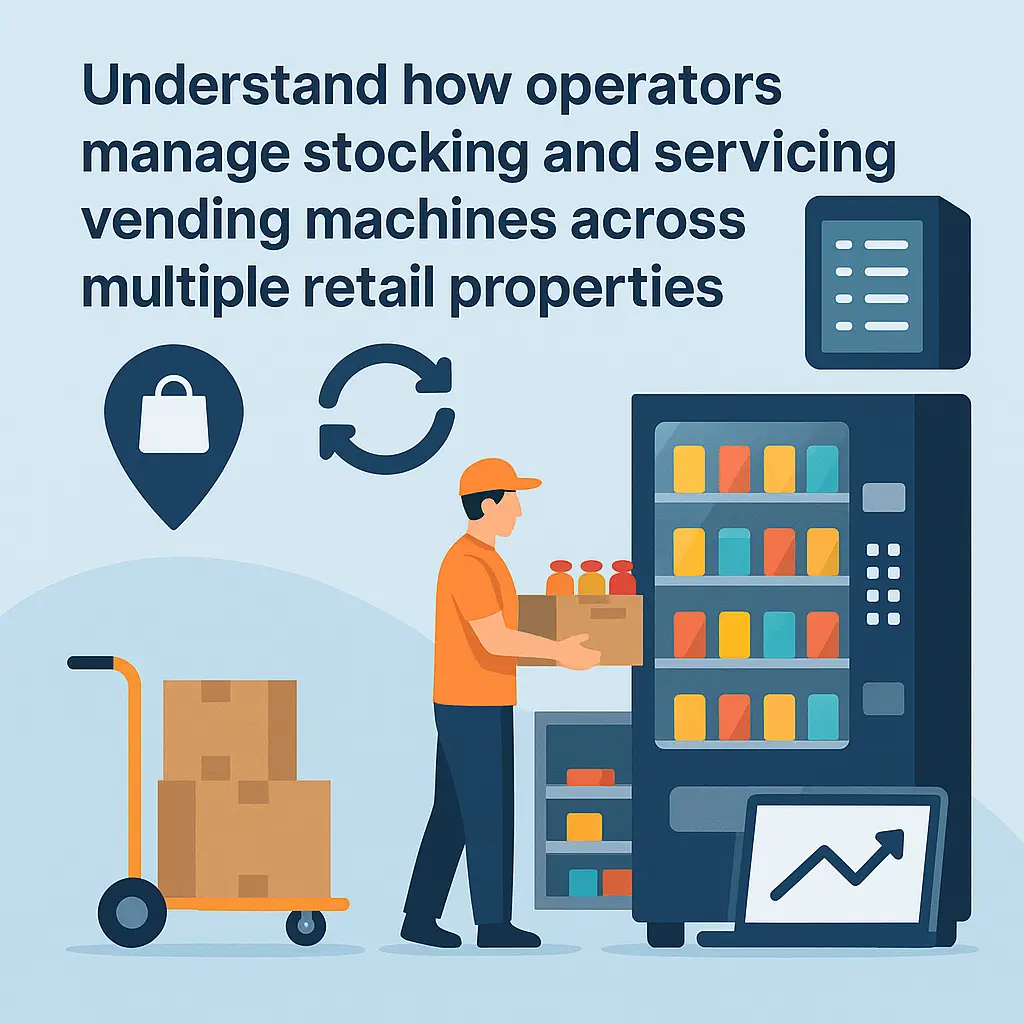Managing Retail Vending Logistics
Understand how businesses manage stocking and servicing vending machines across multiple retail properties.
Back to Vending for Retail Locations ResourcesUnderstand how businesses manage stocking and servicing vending machines across multiple retail properties.
Back to Vending for Retail Locations ResourcesSuccessful retail vending requires precise planning for product assortment, restocking, and maintenance across various sites to ensure continuous customer satisfaction.
![]() Efficient inventory management prevents stockouts and optimizes product mix
Efficient inventory management prevents stockouts and optimizes product mix
![]() Proactive maintenance ensures machines are always operational and reliable
Proactive maintenance ensures machines are always operational and reliable
![]() Strategic route planning minimizes operational costs and improves service efficiency
Strategic route planning minimizes operational costs and improves service efficiency

For large retail businesses with multiple locations, managing a network of vending machines can be a complex undertaking. It requires more than just placing machines; it involves detailed planning, efficient execution, and constant optimization to ensure customer satisfaction and operational efficiency. Understanding the intricacies of retail vending logistics is key to delivering a seamless experience across all properties.
One of the primary logistical challenges is maintaining optimal inventory levels. Each retail location might have unique customer demographics and purchasing patterns. Advanced telemetry systems play a crucial role, providing real-time data on stock levels and sales performance. This allows for data-driven decisions on product assortment and precise restocking schedules, preventing popular items from running out and reducing unnecessary trips. For more on inventory considerations, see this guide to managing vending machine inventory effectively.
Downtime in a retail setting means lost sales and customer frustration. Effective logistics include a robust maintenance strategy. This involves not only reactive repairs but also proactive preventative maintenance schedules. Remote diagnostic tools can often identify potential issues before they cause a breakdown, allowing for scheduled servicing that minimizes disruption to retail operations. Prompt response times for service requests are critical to upholding service quality.
Servicing multiple retail locations demands highly efficient route planning. Logistics teams utilize sophisticated software to create optimized routes that consider traffic patterns, distance between sites, and specific servicing needs of each machine. This minimizes fuel consumption, reduces labor costs, and maximizes the number of machines that can be serviced per day. The goal is to maximize efficiency while ensuring all machines are consistently stocked and operational. Understanding the different types of vending machines for retail also contributes to better logistical planning.
Different retail locations attract different types of customers. A grocery store might benefit from a wider array of healthy snacks and beverages, while a clothing boutique might see higher demand for premium coffee or specialty drinks. Effective retail vending logistics involves analyzing sales data from each site to customize product offerings. This ensures that machines are consistently stocked with items that resonate with the local customer base, increasing sales and customer satisfaction. The insights gleaned from healthy vending trends in public facilities can also inform retail decisions.
Integrating vending solutions into busy retail environments requires careful coordination. Servicing operations are often scheduled during off-peak hours to avoid impacting customer traffic. The process is designed to be quick and unobtrusive, ensuring that the presence of vending machines adds convenience without causing any operational hurdles for the retail business itself. Businesses seeking to enhance their customer amenities without added burden should consider exploring comprehensive vending solutions. Whether you're looking for specialized machines or full-service management, simply fill out the form on this page to discover how easily vending can be integrated into your retail operations.
Advanced telemetry systems continuously monitor stock levels, allowing for efficient route planning and timely restocking to prevent empty machines.
Regular preventative maintenance schedules and remote diagnostic capabilities help identify and resolve issues quickly, minimizing downtime.
Data analytics on sales trends, demographic information, and location-specific demands inform product assortment, ensuring relevant offerings for each retail setting.
Service level agreements (SLAs) with prompt response targets, often within 24-48 hours, are common to address maintenance or technical issues swiftly.
Servicing is often scheduled during off-peak hours or conducted rapidly with minimal equipment and personnel to avoid impacting customer flow.
Modern machines integrate secure cashless payment options (card, mobile) and robust auditing systems to track transactions and prevent fraud.
High-traffic areas, customer waiting zones, employee break rooms, and locations near complementary services are typically prioritized for optimal visibility and use.
Yes, some vending operations can incorporate local brands or products, aligning with community support initiatives and offering unique retail experiences.
Many modern machines are energy-efficient, utilizing LED lighting and smart power management features, with some systems allowing for remote energy monitoring.
Comprehensive reports on sales volume, popular products, inventory levels, machine uptime, and customer feedback are typically provided to businesses.